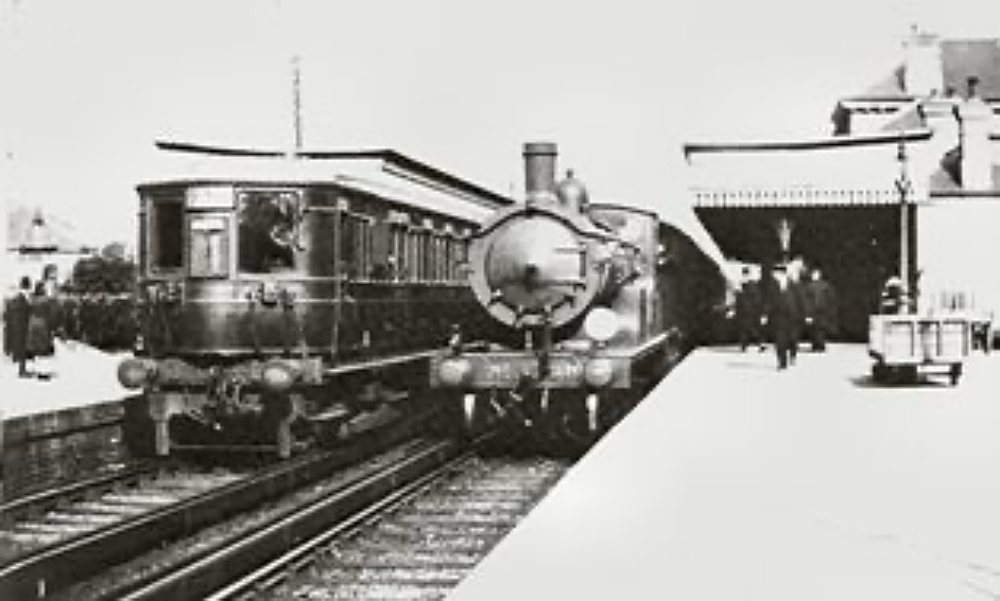Electric Dreams
IT was a sign of exciting progress when on Friday, December 30, 1933, the Lord Mayor of London arrived in Worthing as guest of the Southern Railway, to inaugurate the long-awaited electrification of the railway between London and West Worthing – with all the promise of an increased population of commuters for the town.

SIDE-BY-SIDE: The first electric train draws into Worthing to make an historic picture alongside its steam-driven counterpart.
Worthing town councillors shared the Southern Railway Company’s confidence for the future by agreeing, on January 3, to construct an 18-hole municipal golf course on Lower Warren Farm, Broadwater, at an estimated cost, including clubhouse, garages and other necessary buildings, of £9,200.
Private developers were playing their part in producing an air of growing optimism, despite high unemployment figures.
The same week, details and an artist’s impression were published of the new Hippodrome cinema-cum-theatre to be built in Rowlands Road, with a promise that its doors would open at Whitsun.
In addition, plans were going ahead for two more super-cinemas for the town. One, to be named The Showboat, was to open in June, 1934, while the site of the former Theatre Royal in Bath Place was being cleared for the construction of the Worthing Astoria Cinema.
Faced with such an impressive list of facilities, how could the people of Worthing doubt the prosperity that the following years would bring? The electrification scheme, including new rolling stock and equipment, cost Southern Railway £2.27million, an investment confidently expected to open up a new age of prosperity for the coastal towns it served.
Worthing railway station was decorated with an abundance of flags, bunting and flowers, when the Lord Mayor of London, accompanied by the Sheriffs of the City, arrived in Worthing on one of three brand-new “City Limited” electric trains built for the London-Brighton service.
Like the express corridor coaches to be used on the Worthing-London service, they represented the last word in travelling comfort.
That day, the Southern Railway demonstrated the hoped-for efficiency and reliability of their new service.
Travelling from London, the Lord Mayor and his entourage reached Hove in 56 minutes 40 seconds against the planned time of 59 minutes 30 seconds. There was a slight slowing down on the remaining nine miles, but Worthing Central was still reached in one hour 12 minutes – 90 seconds ahead of schedule.
Today’s commuters, eat your heart out!
Not surprisingly, when the train drew up to the platform at Worthing the passengers “were greeted with a hearty cheer”. Today, such an achievement would have won tumultuous applause. Sadly, the sequence of events that followed fell short of resounding success. Worthing Town Council’s go-ahead for the 137-acre municipal golf course was not without its critics.
Alderman Cook regretted the choice of a site adjacent to the already popular, private Worthing golf course.
He also thought that with a long list of other schemes confronting the council, creating another golf course was an unwise move.
Other members saw the scheme as an excellent opportunity to help some of Worthing’s unemployed.
Plans for the new Hippodrome in Rowlands Road were ambitious – a shade too ambitious, it seems. First drawings revealed it would be “a fine example of modern decorative architecture”.
It was to include a stage large enough to permit 40 sets of scenery to be “flown” and the orchestra pit was to be equipped with a lifting platform to accommodate a 50-piece orchestra and a John Compton organ console.
The Showboat, planned for an undisclosed site, promised even greater excitement.
“The stage setting will include a stage water tank, cyclorama and a special floodlighting gallery.
“It is to be designed on nautical lines, giving an impression of a ship which will be heightened at night by a special system of lighting.
“There will be accommodation for 2,500 people and a café designed like the dining room of a ship, with portholes taking the place of windows.”
The planned Worthing Astoria, in Bath Place, was to seat 1,700 and have provision for a tearoom and lounge. It would be part of a cinema chain.
Some of those dreams of 1933 were to flourish but others faded. Electrification of the railway did bring new blood to the town, but only three weeks after the jubilation that accompanied the opening, a sour note appeared in the letters column of the Worthing Gazette.
“As a railway ticket holder to London for many years, I can say without fear of contradiction that since the arrival of electric trains the business service has never run so badly to schedule.
“The 8.33am from Worthing (although leaving five minutes earlier than its steam counterpart) invariably arrives at London Bridge at anything up to 10 minutes late.
“All have heard of the marvellous penetrating power of the new colour signals, yet the first fog of the year sees the 8.33 drawing into London at 11.30am and the following day, due to breakdown, at 11am.
The golf course did live up to its promise and the Hippodrome (in the event to be named the Plaza) excelled through the heyday of cinema with its queues curling round nearby streets on blacked-out wartime nights. It survives to this day – but as a bingo club.
But the intriguing Showboat and promised Astoria, regrettably, never arrived to tempt the thronging summer crowds.